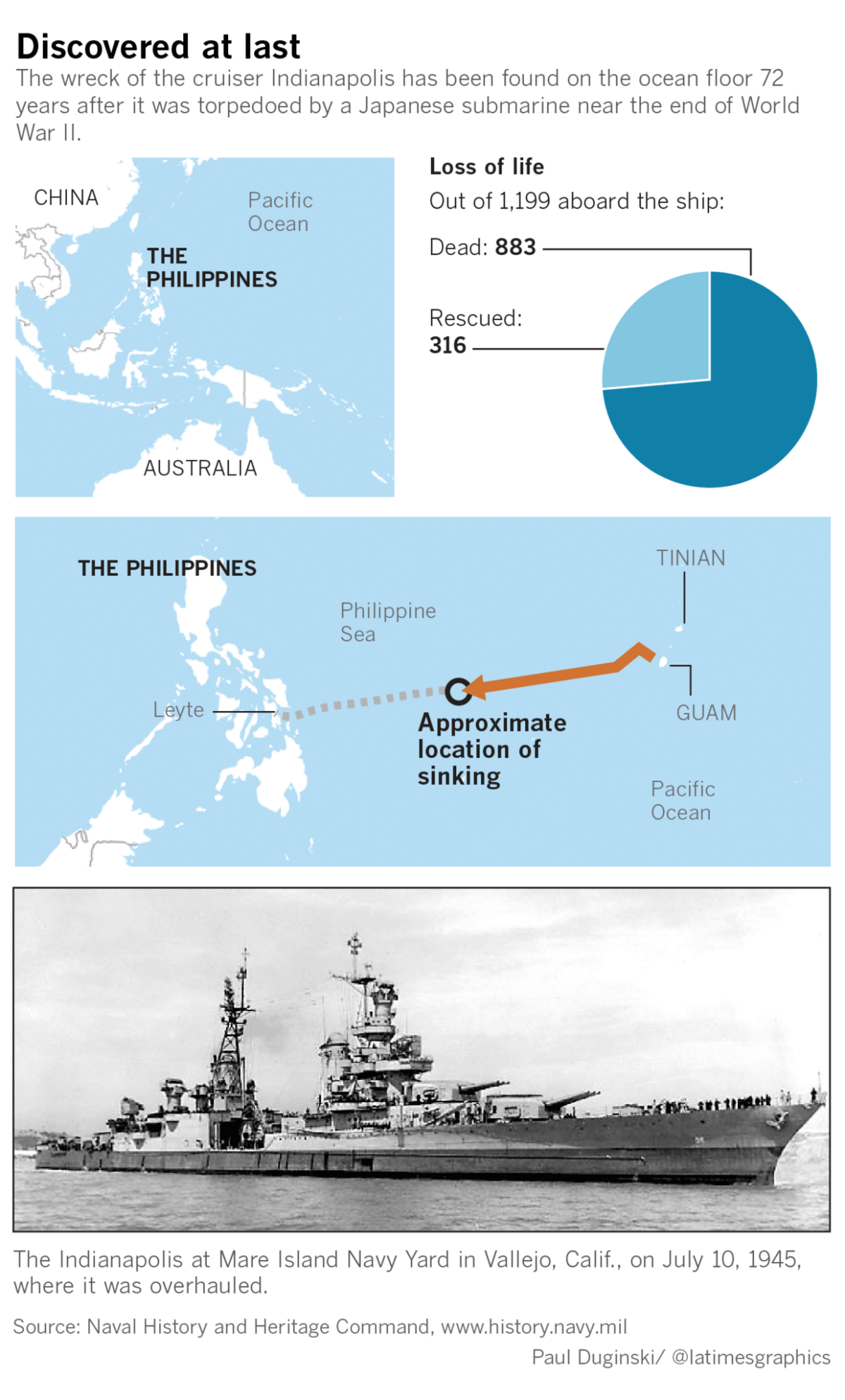Researchers find wreckage of famed Navy cruiser Indianapolis, sunk in 1945
- Share via
A research team led by Microsoft co-founder
The ship’s remains were found Saturday on the floor of the Pacific Ocean nearly 3.5 miles below the surface, the Navy said in a news release. The exact location of the discovery would remain confidential, the Navy said. The ship’s anchor and bell were clearly visible in photographs shared over Twitter.
Allen said in a statement that he hoped the find would bring closure to those connected to an important chapter in World War II history.
"To be able to honor the brave men of the USS Indianapolis and their families through the discovery of a ship that played such a significant role in ending World War II is truly humbling," he said.
The saga of the Indianapolis and the unfathomable suffering of the crew have been recounted in documentaries, movies — most famously in “Jaws” — and books. As Dan Kurzman wrote in the book “Fatal Voyage: The Sinking of the U.S.S. Indianapolis,” the ship’s destruction represents two tragedies — the sinking and the later torment of its captain.
What happened to the Indianapolis?
In July 1945, the Indianapolis had just completed a secret mission to Tinian in the Mariana Islands, where it delivered materials for the atomic bomb dropped on Hiroshima. The cruiser was traveling unescorted to Leyte, an island in the Philippines, when it was hit by a torpedo from a Japanese submarine at 12:14 a.m. on July 30.
The ship sank in 12 minutes, its descent too rapid for a distress signal to be sent.
Of the nearly 1,200 crew members aboard, about 800 survived the sinking. But the survivors were stranded for five days in shark-infested waters. A rescue mission was set in motion when the bobbing survivors were spotted by a plane on a routine reconnaissance flight.

By the time they were rescued, only 316 remained. The rest were killed by exposure, dehydration, drowning and sharks.
In popular culture, the Indianapolis may be best known for the chilling scene in “Jaws” when Quint, the crusty sea captain played by Robert Shaw, describes the ordeal in an increasingly harrowing monologue:
“Sometimes that shark he looks right into you — right into your eyes,” Quint says. “You know a thing about a shark — he’s got lifeless eyes. Black eyes, like a doll’s eyes. When he comes at you, he doesn’t seem to be living, until he bites you.”
Why was it found now?
Allen’s team wasn’t the first to search for the wreckage.
He was aided by the work of Navy historian Richard Hulver, who uncovered a new clue while researching the disaster last year.
Hulver found a blog post recounting the story of a sailor whose ship had passed the Indianapolis hours before it went down. The sailor’s son had posted the tale on the website of the family’s fudge shop in Mackinaw City, Mich.
Hulver was able to corroborate the information by poring through naval records.
Building on that work, Allen’s research team began to search farther west than previous efforts.
They were assisted by a research vessel, the Petrel, that Allen purchased and retrofitted with equipment capable of diving 3.5 miles below the ocean’s surface.
Was anyone held responsible for the Indianapolis’ sinking?
The Indianapolis’ commanding officer, Navy Capt. Charles B. McVay III, was court-martialed on Dec. 19, 1945.
The Navy convicted him of negligence for not ordering the cruiser to travel in a zigzag pattern. McVay was absolved of a second charge of failing to promptly order the crew to abandon ship.
McVay committed suicide in 1968 after reportedly suffering from mental health problems for years. He used his service revolver to kill himself.
Some survivors said that he was unfairly blamed for the disaster, and banded together to launch an effort to clear his name.
That paid off in 2000, when McVay was posthumously exonerated through a resolution passed by Congress and signed by President Clinton.
What was its significance for World War II?
Seven days after the Indianapolis sank, the atomic bomb for which it delivered materials was dropped on Hiroshima.
A week later, following the detonation of a second bomb on Nagasaki, Japan announced its surrender. The American public learned of the Indianapolis tragedy about the same time.
On the front page of the Times’ Aug. 15 edition, a banner headline blares, “Peace! Victory!” Tucked under it is a smaller headline reminding readers of the cost of victory: “Indianapolis Sunk with 883 Killed.”
alexandra.wigglesworth@latimes.com
Twitter: @phila_lex
ALSO
The legend of the blond, blue-eyed slave: Retracing a crashed WWII pilot’s journey through China
Dick Gregory, groundbreaking comedian and civil rights activist, dies at 84
'Thank God nobody got hurt': Boston protesters gather peacefully a week after Charlottesville violence
Sign up for Essential California
The most important California stories and recommendations in your inbox every morning.
You may occasionally receive promotional content from the Los Angeles Times.








